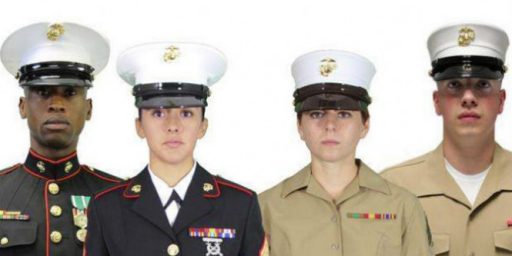Body Armor for Dogs
StrategyPage has a classic example of something that’s almost certainly a good idea that sounds rather odd at first impression:
Military dogs now have body armor. Marine Corps dogs, used for crowd control and other police type work, were equipped with custom made Kevlar body armor (worn like the winter coverings you see some dogs sporting in the cold weather). Costing about a thousand dollars each, the Kevlar will protect the dogs from stab wounds, shell fragments and some bullets. The K-9 Protective Vests weigh about seven pounds, which for a 90 pound German Shepard, is about the same burden as the 17 pound vest worn by the heavier marines. The K-9 vests have some special features as well. There are compartments on the inside of the vests for the insertion of cold packs (soft, flat plastic bags containing a chemical that, when activated, becomes very cool). Since dogs do not deal with heat as effectively as humans (dogs don̢۪t sweat), and Iraq is a very warm place in the Summer, the cold packs can prevent heat stroke. There are also attachments on the vest to enable the dog to be dropped by parachute, or hauled up via a rope. The vests hinder the dogs mobility a bit, especially when they are jumping. But the dogs have quickly adjusted to the vests.
The expense of the vests is justified because of the value of the dogs, and the hostility that Arabs have towards dogs (it’s a cultural and religious thing.) The dogs take over a year, and some $60,000, to train. They are used for sniffing for explosives at checkpoints, crowd control and for detecting enemy troops on some patrols. So spending some money on life saving equipment for the dogs is a good investment.
There are currently some 1,400 dogs in service for the U.S. military. During World War II, some 10,000 dogs were taken into military service, and in the Vietnam war, some 4,000 dogs were trained and sent over, where 281 were killed in combat. The marines used 327 dogs in the Pacific during World War II, and 29 died in battle. The marines found the dogs particularly useful for detecting Japanese troops, who were expert at camouflage, and setting up ambushes.
Until 2000, when the law was changed, military dogs were used until they were about ten years old, then killed. It was thought that the retired military dogs could not adapt to family life. But decades of police, and some military experience, with dogs living safely with their handlers and family members finally caused the policy to be changed. Dog handlers had long urged that retired dogs be allowed to stay with their handlers, or be put up for adoption.
Of course, it would be nice to have the latest body armor for all our human troops, too.




